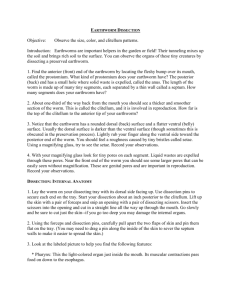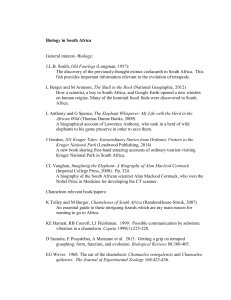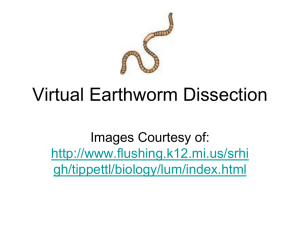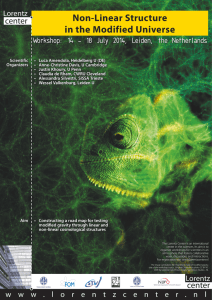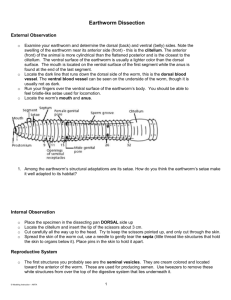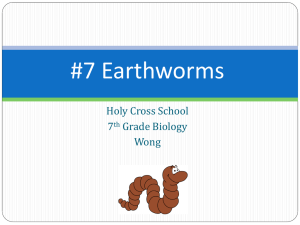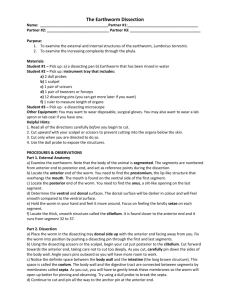seminal receptacles
advertisement
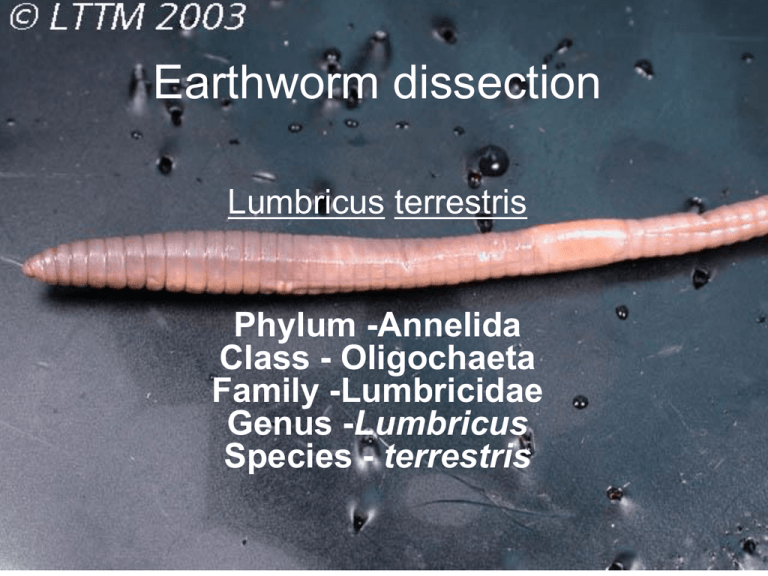
Earthworm dissection Lumbricus terrestris Phylum -Annelida Class - Oligochaeta Family -Lumbricidae Genus -Lumbricus Species - terrestris Cartoon of the Day! Cartoon of the Day! Cartoon of the Day! Cartoon of the Day! Cartoon of the Day! Seminal Receptacles Seminal Vesicles Circulatory system • The pumping organs of the circulatory system are five aortic arches. • Circulatory fluids travel from the arches through the ventral blood vessel to capillary beds in the body. The fluids then collect in the dorsal blood vessel and reenter the aortic arches. Dorsal Blood Vessel Digestive system • The earthworm takes in a mixture of soil and organic matter through its mouth, which is the beginning of the digestive tract. The mixture enters the pharynx, which is located in segments 1–6. pharynx • The esophagus, in segments 6–13, acts as a passageway between the pharynx and the crop. The crop stores food temporarily. Crop • The mixture that the earthworm ingests is ground up in the gizzard. In the intestine, which extends over two-thirds of the body length, digestion and absorption take place. Soil particles and undigested organic matter pass out of the worm through the rectum and anus. Gizzard Nervous System The nervous system consists of the ventral nerve cord, which travels the length of the worm on the ventral side, and a series of ganglia, which are masses of tissue containing many nerve cells. Ventral Nerve Cord • The nerve collar surrounds the pharynx and consists of ganglia above and below the pharynx. Nervous impulses are responsible for movement and responses to stimuli. Each segment contains an enlargement, or ganglion, along the ventral nerve cord. Respiration • The earthworm has no gills or lungs. Gases are exchanged between the circulatory system and the environment through the moist skin. • Possible practical questions: • 1. Describe the external body of the earthworm. • 2. Where are the setae and how many are there? • 4 What do you need to avoid cutting when making the first cut? • 5. What is the body cavity called? • 6. List the order that thing pass as going through the digestive system of the worm? • 7. Label a diagram of the ventral side of the worm and label the mouth, prostomium, setae, sperm groove, openings of seminal receptacles, male genital pore and clitellum • 8. Briefly describe the systems of the earthworm – Digestive, Circulatory, respiratory, reproductive • 9. Be able to label the parts of the internal and external structures. • • • • • • • • • 1. Describe the external body of the earthworm. 2. How can you tell ventral from dorsal? 3. Where are the setae and how many are there? 4. Draw a diagram of the ventral side of the worm and label the mouth, setae and clitellum. 5. What do you need to avoid cutting when making the first cut? 6. What is the body cavity called? 7. What are the compartments called? 8. List the order that thing pass as going through the digestive system of the worm? 9. Briefly describe the systems of the earthworm – Circulatory, respiratory, reproductive 10. Be able to label the parts of the internal and external structures. Label a diagram • color code the systems Cartoon of the Day Cartoon of the Day! Organism of the Day Chameleon: Chamaeleo chamaeleon Kingdom: Animalia Phylum: Chordata Class: Reptilia Order: Squamata Suborder: Lacertilia Infraorder: Iguania Family: Chamaeleonidae Chameleon Fun Facts • They are distinguished by their parrot-like zygodactylous feet, their separately mobile and stereoscopic eyes, their very long, highly modified, and rapidly extrudable tongues, their swaying gait, the possession by many of a prehensile tail, crests or horns on their distinctively shaped heads, and the ability of some to change color. Chameleon Fun Facts 2 • The primary purpose of color change in chameleons is social signaling, with camouflage secondary. Color change signals a chameleon's physiological condition and intentions to other chameleons. Chameleons tend to show darker colors when angered, or attempting to scare or intimidate others, while males show lighter, multicolored patterns when courting females. • Life span 5-8 years on average. Clutch size can range from 3-5 eggs for some species and 80-100 for others. There are 160 species of Chameleon in the world. COOL! Cartoon of the Day! Organism of the Day • Jewel Wasp- Ampulex compressa Kingdom: Animalia Phylum: Arthropoda Class: Insecta Order: Hymenoptera Family: Ampulicidae Genus: Ampulex Species: A. compressa Jewel Wasp Facts • The emerald cockroach wasp or jewel wasp (Ampulex compressa) is a solitary wasp of the family Ampulicidae. It is known for its unusual reproductive behavior, which involves stinging a cockroach and using it as a host for its larvae. It thus belongs to the entomophagous parasites. Other Gems…. The Jewel Wasp was introduced to Hawaii by F.X. Williams in 1941 as a method of biocontrol. This has been unsuccessful because of the territorial tendencies of the wasp, and the small scale on which they hunt. The wasp has a metallic blue-green body, with the thighs of the second and third pair of legs red. The female is about 22 mm long; the male is smaller and lacks a stinger. Zombies!!! • The Jewel wasp stings precisely into specific ganglia of the roach. It delivers an initial sting to a thoracic ganglion and injects venom to mildly and reversibly paralyze the front legs of its victim. Temporary loss of mobility in the roach facilitates the second venomous sting at a precise spot in the victims head ganglia (brain), in the section that controls the escape reflex. As a result of this sting, the roach will first groom extensively, and then become sluggish and fail to show normal escape responses. And then…. • Adults live for several months. Mating takes about one minute, and only one mating is necessary for a female wasp to successfully parasitize several dozen roaches. Cartoons of the Day Cartoons of the Day Cartoons of the Day Cartoons of the Day Cartoons of the Day Cartoons of the Day Organism of the Day Chameleon: Chamaeleo chamaeleon Kingdom: Animalia Phylum: Chordata Class: Reptilia Order: Squamata Suborder: Lacertilia Infraorder: Iguania Family: Chamaeleonidae Chameleon Fun Facts • They are distinguished by their parrot-like zygodactylous feet, their separately mobile and stereoscopic eyes, their very long, highly modified, and rapidly extrudable tongues, their swaying gait, the possession by many of a prehensile tail, crests or horns on their distinctively shaped heads, and the ability of some to change color. Chameleon Fun Facts 2 • The primary purpose of color change in chameleons is social signaling, with camouflage secondary. Color change signals a chameleon's physiological condition and intentions to other chameleons. Chameleons tend to show darker colors when angered, or attempting to scare or intimidate others, while males show lighter, multicolored patterns when courting females. • Life span 5-8 years on average. Clutch size can range from 3-5 eggs for some species and 80-100 for others. There are 160 species of Chameleon in the world. COOL! Background: • Among the most familiar invertebrate animals are the earthworms, members of the phylum Annelida. The word annelida means "ringed" and refers to a series of rings or segments that make up the bodies of the members of this phylum. Internally, septa, or dividing walls, are located between the segments. There may be more than 100 segments in an adult worm. • The clitellum is a swelling of the body found in sexually mature worms and is active in the formation of an egg capsule, or cocoon. clitellum Reproductive system • Eggs are produced in the ovaries and pass out of the body through female genital pores. Sperm are produced in the testes and pass out through tiny male genital pores. During mating, sperm from one worm travel along the sperm grooves to the seminal receptacles of another worm. Fertilization of the eggs takes place outside the body as the cocoon moves forward over the body, picking up the eggs of one worm and the sperm of its mate.
